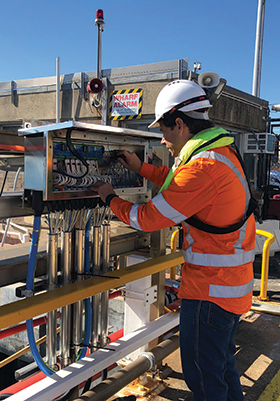
Cathodic protection (CP) systems are widely used in mining operations, protecting anything from conveyor systems to settling tanks, and even large wharf structures, so that they can withstand corrosion. However, because of the dangerous nature of the environment they’re based in, managing these systems is not without its challenges. For example, relying on in-person site visits and manual inspections to monitor system performance increases personnel time in potentially unsafe areas of the mine, and adds health and safety risks. David Celine, managing director of remote monitoring specialist, Omniflex, explains how these challenges can be addressed by implementing industry-certified remote monitoring systems.
Mining operations are often rugged in nature and can be dangerous environments to work in, meaning that health and safety is a key consideration for operating companies and site managers. Furthermore, mines are often situated in extremely remote areas, and getting workers to and from mines can be time-consuming and expensive. Managing personnel visits can be logistically challenging because of the considerations that must be balanced.

CP systems are widely used throughout mining operations, protecting a range of steel and concrete structures, including conveyor systems, settling tanks and large wharf structures from the ongoing threat of corrosion. Traditionally, mine operators have relied on in-person site visits by external CP consultants, who inspect CP systems manually to see if their systems are performing as intended and arrange any maintenance required. However, this approach is problematic for three key reasons.
Firstly, manual inspection results in more personnel time being spent in risky areas of the mine and adds to ongoing safety concerns for operators. Secondly, operators only get infrequent snapshots of system performance as and when inspections are conducted, and this delays the identification of any faults that may arise between inspections. Thirdly, paying expensive consultants to visit remote mining sites in person, often for days at a time, means that mining operators typically spend thousands of dollars a year on manual CP system inspections.
The impact of remote monitoring
Remote monitoring addresses all these challenges. First and foremost, it lowers time spent in dangerous areas by consultants, as they can access system performance data remotely. Next, remote monitoring is operational 24/7, giving mine operators more insight into ongoing system performance compared with periodic manual inspections conducted during site visits. Finally, remote monitoring is proven to save operators significant costs as it dramatically reduces the need for in-person site visits by expensive consultants to inspect system performance.
Another benefit of implementing remote monitoring technology in mining environments is that it helps operators conduct effective CO2 reporting, something that is becoming an increasingly important requirement because of the industry’s high power consumption. 24/7 remote monitoring increases an organisation’s ability to monitor and report on energy usage; and the enhanced data auditing ability improves the site manager’s ability to identify underlying causes of any onsite performance or safety issues.
The improvement in management oversight cannot be underestimated, as automated reporting and the ability to aggregate data saves management time in processing the data into metrics than can be continuously monitored to manage a business.
Omniflex’s remote monitoring technology has been approved for use in BHP coal mines and across large Australian-based enterprises like the Port of Melbourne, as it is robust enough to work reliably in potentially unsafe environments and complies with stringent cybersecurity demands. This means that mine operators can trust that the systems are up to the job, as they have already proven themselves in the field.

© Technews Publishing (Pty) Ltd | All Rights Reserved